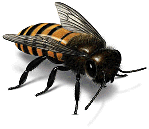
EXPERIMENT 1 (Labs 2 and 3)
Honeybee EST project

Schedule
|
Lab 2 -DNA purification for EST analysis |
|
Lab 3 -Restriction enzyme digest and agarose gel -Prepare DNA for DNA sequencing -Send DNA for sequencing |
Goal: To sequence and analyze a novel Honeybee Expressed Sequence Tag.
This is the closest you will get to research in an undergraduate laboratory. You will be determining part of the DNA sequence of an unknown clone that represents the sequence of an expressed RNA. The goal is to determine as much information about the gene you have identified.
Background
The honeybee is a high priority for genome sequencing because of its agricultural importance as a pollinator, and its complex behavior.
The EST's that you are going to sequence were generated in the Laboratory of Dr. Gene E. Robinson. So many thanks are owed Dr. Gene Robinson for sending us the clones.
The paper describing the Bee EST project.
Below are web sites that give information on the Honeybee genome projects.
A) Why are you sequencing Honeybee ESTs?
1.) The honeybee genome sequence is 95% complete; therefore, the EST sequence may be aligned with the genomic sequence. 2.) About 20,000 bee ESTs were sequenced and 8,912 transcripts identified; therefore, there is a good chance with honeybee ESTs of describing a unique honeybee gene, because we might expect that the Honeybee genome contains 14,000 to 18,000 genes.
B) What you need to know to do the experiment:
Structure of the pT7T3-Pac vector used to make the library of ESTs.
Structure of the clone carrying the Honeybee EST.
Note that the EST is directionally cloned into T7T3-Pac such that the 5' end of the mRNA cDNA copy is inserted next to the EcoRI restriction enzyme site, and the 3' end of the mRNA cDNA copy is inserted next to the NotI restriction enzyme site. To determine 5' EST sequence, we must use a T7 primer. If we want to determine 3' EST sequence we must use a T3 primer.
C) Practice Example
You may use the following EST sequence to practice and familiarize yourself with the honeybee genome resource.
Reference material
Modern Genetic Analysis 2nd edition
Pages 32-37
Pages 60-70
Pages 217-220
Pages 222-226
Pages 236-239
Pages 269-271
Pages 293-303